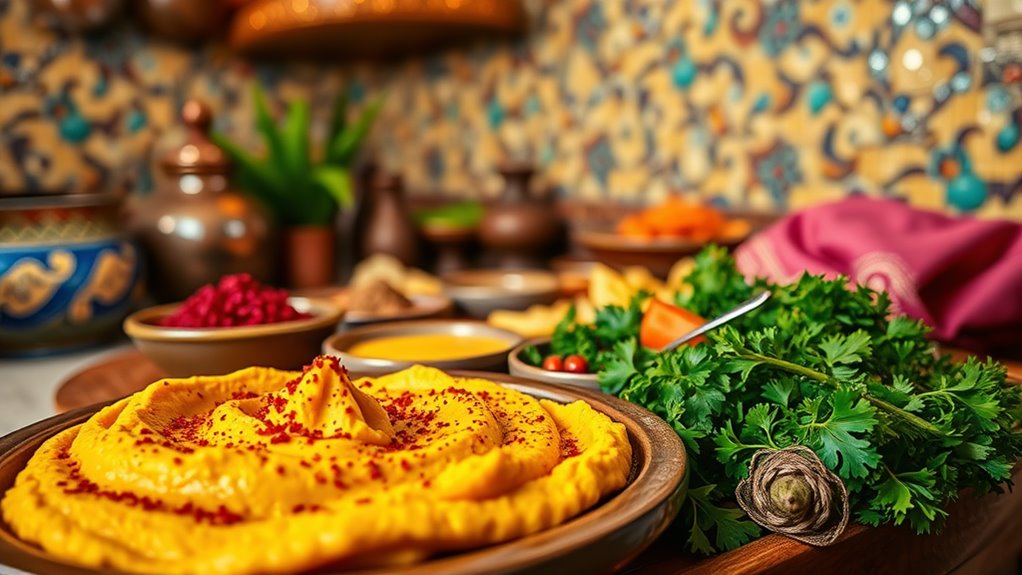As you delve into the historical roots of Arab cuisine, you’ll discover a rich tapestry of flavors and traditions that have been woven over centuries. The dynamic influence of Arab culture is not just confined to the kitchen; it extends across cultures, driving modern trends in the hospitality industry. For those interested in diversifying their interests, Top Saudi Arabia Online Casinos offer a unique blend of entertainment that also draws on regional cultural themes.

Historical Roots of Arab Cuisine
As you delve into the historical roots of Arab cuisine, you’ll discover a rich tapestry of flavors and traditions that have been woven over centuries.
You’ll find that Arab cuisine’s development is closely tied to the region’s strategic trade position. Merchants and travelers introduced new ingredients, influencing local cooking techniques. This cultural exchange shaped the cuisine’s unique character.
You’ll notice the impact of Islamic traditions, too, with an emphasis on hospitality and generosity.
As you explore Arab cuisine’s history, you’ll uncover a complex, fascinating narrative that underscores its profound influence on global culinary practices, with each dish telling a story.
Spices and Flavors of the Middle East
The aromatic landscape of the Middle East unfolds with each dish, a symphony of spices and flavors that you’ll find yourself navigating with curiosity.
You’ll discover the warmth of cumin, coriander, and cinnamon, which add depth to various dishes. As you explore, you’ll notice the subtle nuances of sumac, cardamom, and rose water, which evoke a sense of refinement.
The boldness of baharat and the pungency of za’atar will also intrigue you. You’ll appreciate the intricate balance of these spices and flavors, which define the essence of Middle Eastern cuisine. This complex interplay will leave you wanting to learn more.
Arab Influence on Mediterranean Cuisine
Middle Eastern spices and flavors have woven their way into the fabric of nearby cuisines, and you’ll find their fingerprints on Mediterranean dishes.
You’ll notice the subtle presence of cumin, coriander, and sumac in Greek, Turkish, and Lebanese cooking. As you explore Mediterranean cuisine, you’ll discover that Arab influences have shaped the region’s culinary identity.
The use of olive oil, garlic, and lemon juice has been refined by Arab culinary traditions. You’ll experience the richness of Arab-Mediterranean fusion in dishes like shawarma, falafel, and kebabs, which showcase the beautiful blend of flavors and techniques.
The Spread of Arab Cuisine Through Trade
When you delve into the history of Arab cuisine, you’ll find that trade played a pivotal role in spreading its flavors and techniques across the globe. As merchants traveled along the Silk Road, they carried exotic spices, nuts, and dried fruits, introducing them to new regions.
You’ll discover that Arab traders also brought their culinary expertise, sharing techniques like preserving and pickling. This exchange of goods and knowledge facilitated the dissemination of Arab cuisine, allowing it to blend with local flavors and create new ones.
You’ll see the impact of this trade in the diverse cuisines that have evolved over time.
Adaptation and Evolution of Arab Dishes
As you explore the adaptation and evolution of Arab dishes, you’ll find that local ingredients and culinary traditions have significantly shaped their development, leading to a fascinating array of innovative flavors and techniques.
You’ll notice that Arab cuisine has seamlessly incorporated regional elements, creating unique fusion dishes. The use of native spices, herbs, and produce has refined the character of Arab dishes, making them distinct and flavorful.
This blending of traditions has resulted in a rich culinary landscape, with each region offering its own interpretation of Arab cuisine, showcasing the dynamic nature of its adaptation and evolution.
Global Legacy of Arab Culinary Traditions
The adaptation of Arab dishes to local ingredients and traditions has yielded a vibrant tapestry of flavors, and you’ll find that this process has had far-reaching implications.
As you explore the global legacy of Arab culinary traditions, you’ll discover a rich cultural exchange. You’ll see how Arab spices, like cumin and coriander, have infused local cuisines with distinct flavors.
This cross-cultural exchange has created a unique gastronomic identity, shaping the course of world cuisine.
You’ll appreciate the nuances of Arab culinary traditions, now woven into the fabric of global cuisine, as you savor the flavors of this enduring legacy.
losing Remarks
As you delve into the world’s culinary landscape, you’ll discover Arab culture’s profound imprint. The nuances of cumin, coriander, and olive oil have woven a rich tapestry of flavors, transcending borders. You’ll find that Arab traditions have evolved, adapted, and thrived, leaving an enduring legacy that resonates globally, a testament to the power of cultural exchange and culinary innovation.